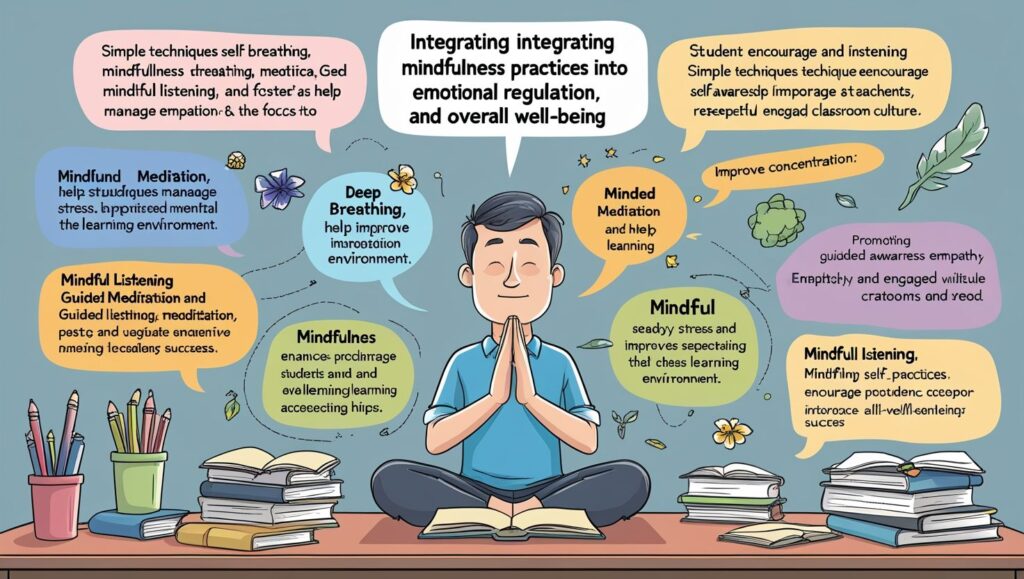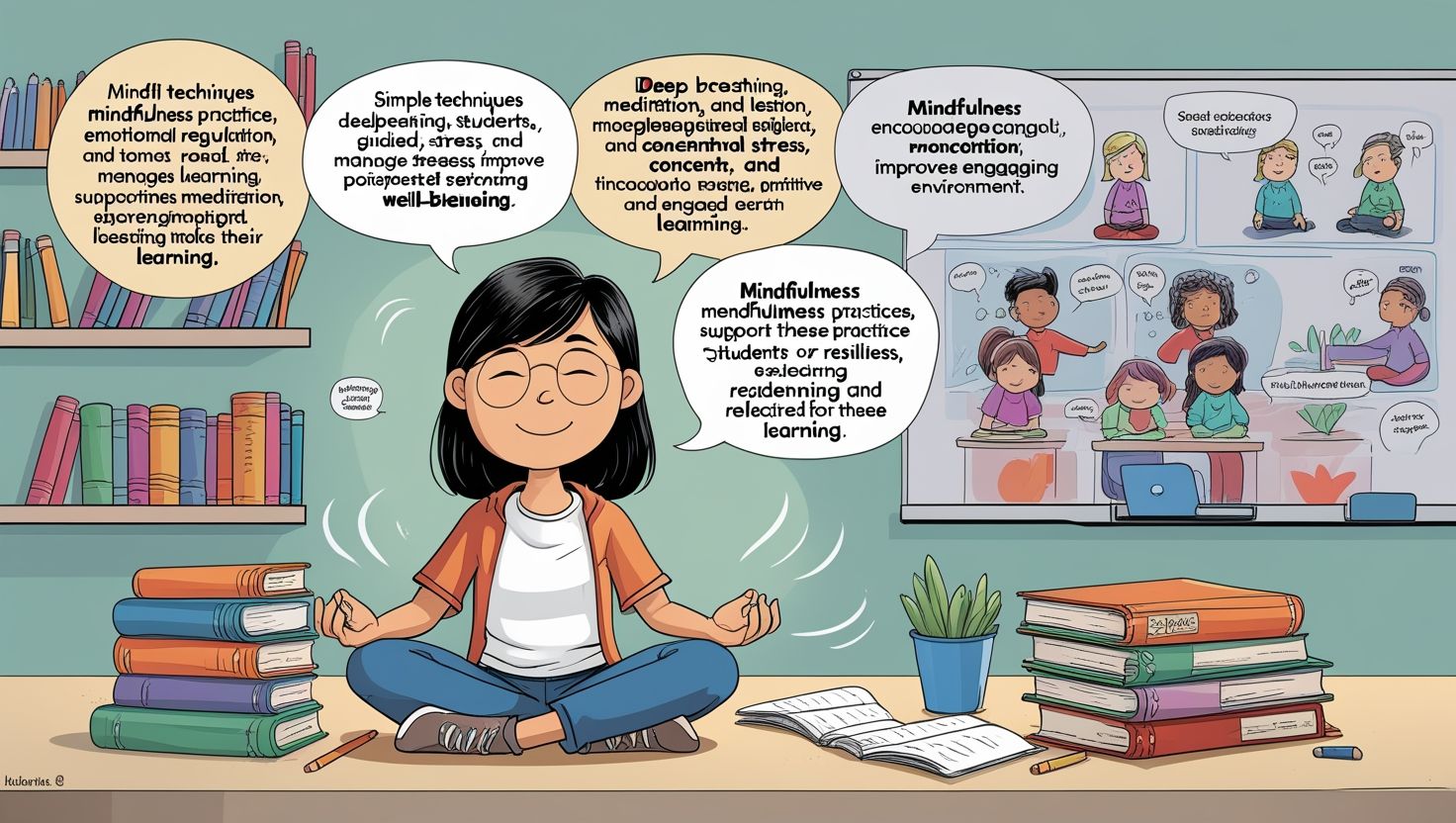Integrating Mindfulness Practices into the Classroom, In recent years, mindfulness has gained significant attention as a powerful tool for enhancing mental well-being, focus, and emotional regulation. As educators strive to create supportive and effective learning environments, integrating mindfulness practices into the classroom has emerged as a promising approach. Mindfulness, defined as the practice of paying attention to the present moment without judgment, can help students and teachers alike manage stress, improve concentration, and foster a positive classroom atmosphere. This article explores the benefits of mindfulness in education, practical strategies for implementation, and tips for overcoming potential challenges.
The Benefits of Mindfulness in Education
Mindfulness practices offer a wide range of benefits for students and teachers. For students, mindfulness can improve attention span, reduce anxiety, and enhance emotional resilience. In an era where distractions are abundant, teaching students to focus on the present moment can help them engage more deeply with their studies. Research has shown that mindfulness can also improve academic performance by boosting memory and cognitive flexibility. Additionally, mindfulness practices can foster empathy and compassion, promoting a more inclusive and supportive classroom culture.
For teachers, mindfulness can serve as a valuable tool for managing stress and preventing burnout. Educators often face high levels of pressure, and mindfulness techniques such as deep breathing or brief meditation can help them stay calm and focused. By modeling mindfulness, teachers can also create a more mindful classroom environment, encouraging students to adopt similar practices.
Practical Strategies for Integrating Mindfulness
Integrating mindfulness into the classroom does not require a complete overhaul of the curriculum. Instead, it can be woven into daily routines through simple, consistent practices. Here are some practical strategies for incorporating mindfulness into the classroom:
- Mindful Breathing Exercises: Begin the day or transition between activities with a brief mindful breathing exercise. Encourage students to close their eyes, take deep breaths, and focus on the sensation of breathing. This practice can help students center themselves and prepare for learning.
- Mindful Listening: Incorporate mindful listening activities to improve focus and communication skills. For example, play a piece of music or a sound from nature and ask students to listen carefully, noting the details they hear. This activity can also be adapted for group discussions, encouraging students to listen attentively to their peers.
- Body Scan Meditation: Guide students through a body scan meditation to help them become more aware of physical sensations and release tension. This practice can be particularly useful before tests or during stressful periods.
- Mindful Movement: Incorporate gentle stretching or yoga into the classroom routine. Mindful movement can help students release physical tension and improve focus. Even a few minutes of stretching can make a significant difference.
- Gratitude Practices: Encourage students to reflect on things they are grateful for. This can be done through journaling or group discussions. Gratitude practices can foster a positive mindset and strengthen social connections.
- Mindful Transitions: Use mindfulness to ease transitions between activities. For example, ask students to pause and take three deep breaths before moving on to the next task. This simple practice can help students reset and refocus.

Overcoming Challenges in Implementation
While the benefits of mindfulness are clear, implementing these practices in the classroom can present challenges. One common concern is the lack of time in an already packed curriculum. However, mindfulness practices do not need to be time-consuming. Even a few minutes a day can have a significant impact. Teachers can integrate mindfulness into existing routines, such as morning meetings or transitions between subjects.
Another challenge is resistance from students or parents who may not understand the value of mindfulness. To address this, educators can provide information about the benefits of mindfulness and involve parents in the process. Sharing research and success stories can help build support for mindfulness initiatives.
Finally, some teachers may feel unprepared to lead mindfulness practices. Professional development opportunities, such as workshops or online courses, can help educators build their skills and confidence. Additionally, there are many resources available, including guided meditations and mindfulness apps, that can support teachers in implementing these practices.
Creating a Mindful Classroom Culture
To fully integrate mindfulness into the classroom, it is important to create a culture that values and supports these practices. This involves modeling mindfulness as a teacher and creating a safe, nonjudgmental space for students to explore these techniques. Encourage students to share their experiences and reflections, and be open to adapting practices to meet their needs.
Incorporating mindfulness into the classroom is not just about teaching techniques; it is about fostering a mindset of awareness, compassion, and resilience. By prioritizing mindfulness, educators can help students develop the skills they need to navigate the challenges of school and life with greater ease and confidence.
Conclusion
Integrating mindfulness practices into the classroom offers a wealth of benefits for both students and teachers. From improving focus and emotional regulation to fostering a positive classroom culture, mindfulness can transform the learning environment. By starting with simple, consistent practices and addressing potential challenges, educators can successfully incorporate mindfulness into their teaching. Ultimately, mindfulness is not just a tool for the classroom—it is a lifelong skill that can empower students to thrive in all areas of their lives. As more schools embrace mindfulness, the potential for creating healthier, more compassionate, and more effective learning communities continues to grow.

6 thoughts on “Integrating Mindfulness Practices into the Classroom”
Comments are closed.